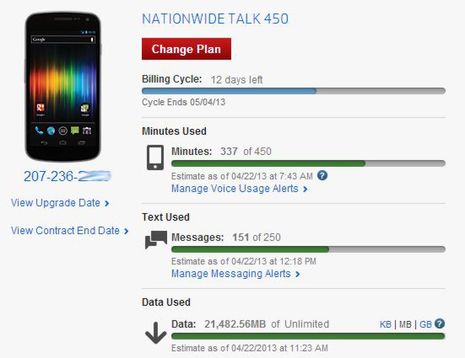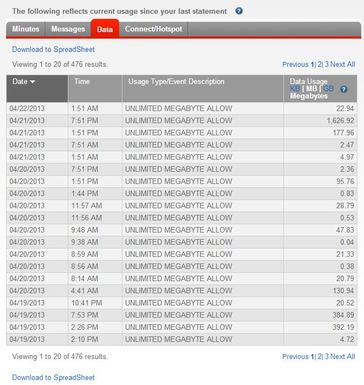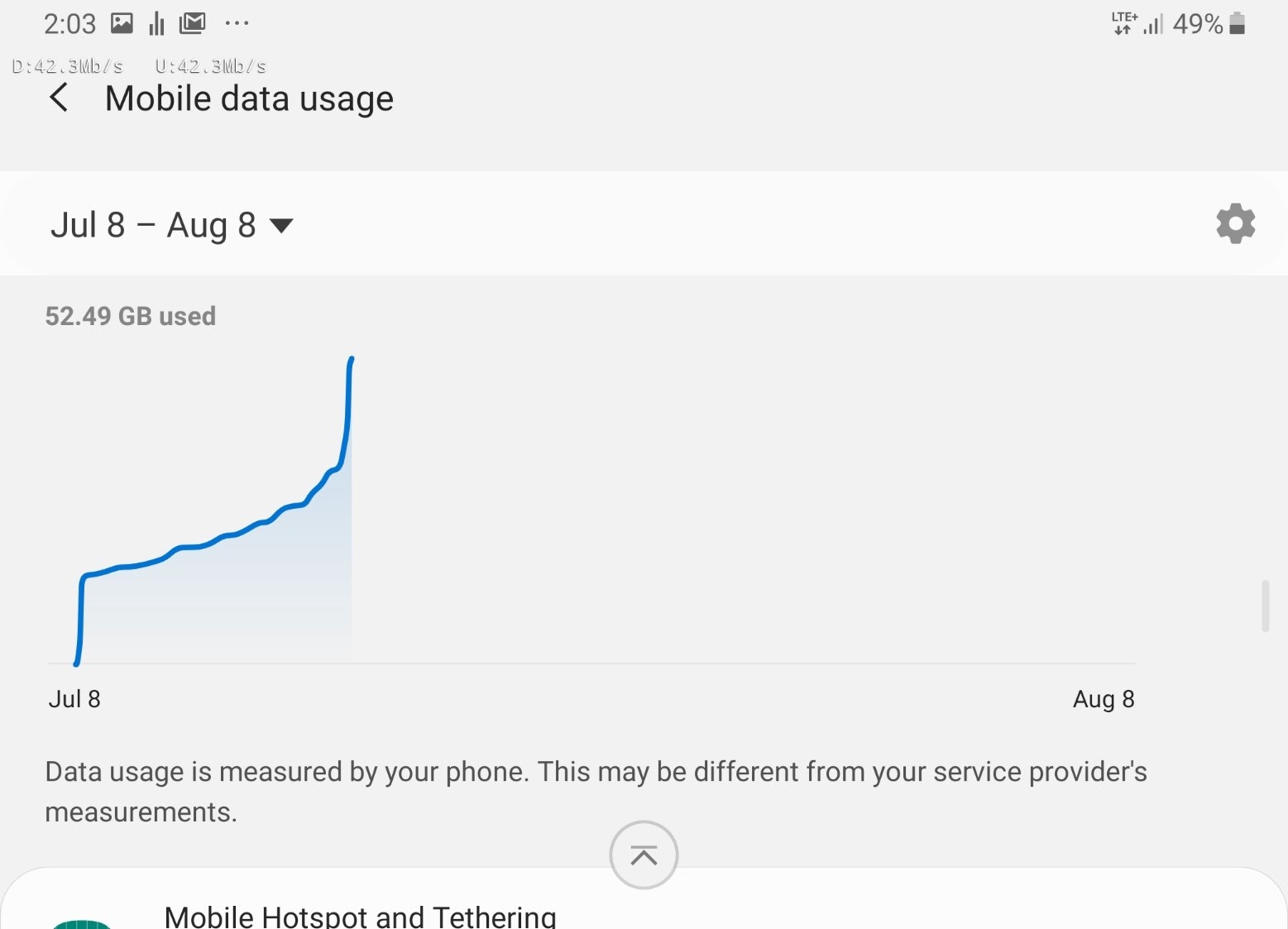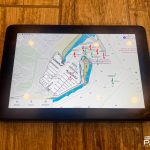Verizon LTE nirvana, can it last?
I lucked out. Just look at all the data I’ve been slurping through my Verizon Galaxy Nexus cell phone while living and working afloat. Up until this month I didn’t think that using 21,482 megabytes on a $60 data plan was possible without repercussions — like Verizon throttling me down or even saying “bye-bye, buster!” But apparently it’s perfectly OK for me to keep right on slurping at this piggish pace. Am I just enjoying a short term sweet spot?
When describing my three-layer data strategy last fall, I was a little shy about detailing the cellular part. I am one of the millions of Verizon users who have a grandfathered $30 unlimited data plan, and also one of the much smaller cohort who luckily updated to an LTE-capable phone before Verizon stopped selling them under an unlimited contract, but I had the strong impression that “unlimited” had certain limitations. When I first went on Verizon’s plan in 2010 I was darn happy that a $10 app let me tether the phone to the boat’s computer via USB cable but was warned that if I used more than 5 gigabytes Verizon could cut me off siting that endless small print known as “Terms of Service”.
So last fall I was still happily using EasyTether but doing so quite judiciously. And when mistakes were made — be careful how you set up GoogleDrive on the boat PC, kids — I’d add Verizon’s mobile hotspot option to my account, which meant I could legitimately use 3 Gigs of cell data on PCs and pads for another $30. I figured that even if my ‘unlimited’ tethering went over 5 gigs, Verizon might appreciate my willingness to pay more for data…
I really like how Verizon lets customers know exactly what’s going on with their account via the MyVerizon site, their smart phone apps or even by calling its elaborate customer service system. I could easily see how much data I was using and could enable or disable the hotspot option without penalty. Also, as illustrated above, Verizon offers a slick alerting system so you don’t actually need to check in on usage. (Letting us rack up expensive extra minutes, texts, and megabytes might be profitable in the short term but not over the long game.) However, that alert screen as well my detailed billing looks different than it did last fall. Back then they differentiated between my ‘unlimited’ and hotspot plans, and I was nervous about what that revealed.
Things change. When I left marina WiFi behind three weeks ago, I was quite bummed to discover that EasyTether wouldn’t connect to Gizmo’s PC any more. Would I only have ‘unlimited’ on the phone’s little screen and be limited to 3 gigs a cruising month on all my other devices unless I found or purchased WiFi services, or send Verizon more money? That’s what I feared as I learned how the latest Android revision made third-party tethering difficult even as the FCC told Verizon it couldn’t limit tethering. Maybe that latter news is why Verizon suddenly lumped all my regular and hotspot data usage into one unlimited bundle, I don’t know, but when I realized that I decided to quit messing with EasyTether and other ways to make my phone do something the service provider didn’t mean it to do. Instead, I’d see if Verizon’s new policy really meant unlimited data for $60/mo…
So far, so good. But you do need some speed to use a lot of data, and, wow, does LTE have it! I’ve seen a lot of snappy 4G service during these trips, thanks in part to Wilson cell amps, but this morning’s speed test results are extraordinary. I don’t think I’ve ever seen 24 Mbps download speed on my home office connection and I pay Time Warner for a premium plan. You also need to download a lot of data…
The screen above is another example of how transparent Verizon is about customer usage, but what you should particularly note is the 1,626 megs I used last night (and I don’t stay up late). How did I manage that? Easy: Netflix streaming at HD quality and without burps to the Visio TV/monitor for two hour-long episodes of a trashy cable series I’ve gotten into. And I mean easy. As shown on the screen below left I enabled the phone’s WiFi hotspot feature when I got to this anchorage yesterday and it’s been sitting in its cradle with charging wire attached and a near perfect LTE signal (middle screen) ever since. I have Gizmo’s Rogue Wave pointed at the PanboAndroid hotspot — though it sees dozens of other APs in this Jersey shore town, none are fast and friendly — so the PCs and pads have all been well connected.
Admittedly, it’s not been so easy when underway or in less well served spots, which is why I appreciate the KVH V3-IP (though even a Russian oligarch might blanch at the bill for 26.5 gigs of satellite data). Will I ever see cellular data so fast and inexpensive again? I have no idea. I did call Verizon today and a sweet lady assured me that I really do have unlimited hotspot data, but she also said that I couldn’t get it again if I want to upgrade my phone with a new contract. I’ve also read that Verizon is throttling ‘unlimited’ 3G users and I’ve seen many arguments raging over whether they’ll kill ‘unlimited’ altogether and/or if it’s even possible given our lust for streaming video. It’s neat, though, that the most informed argument I’ve seen is on Verizon’s own forum.
This line got my attention: “Asking for unlimited data at this point is like satellite internet customers asking them to increase the speed of light so they can have sub 500 ms latency.” Of course I’m curious how other boating cell users are faring and where you all think it’s headed. But I may be offline watching some bad TV for a while…


















Hi Ben,
We’ve got quite a bit of experience in this area. The overarching “logic” behind the level of service you receive is something called “SMP” for “Subscriber Management Policy”. The basic idea is that you are on a shared service with every other Verizon customer using the particular cell tower. If you’re the only user, you’re not harming anybody else by downloading a lot of data so they give it to you — kind of like a first class upgrade when the plane is empty. When the convention comes to town, automatic programs kick in to see not only how much data you download, but how fast. If you start streaming high def movies from Netflix or via some peer to peer protocol that is difficult to block, the automatic throttlers kick in to slow you down for a period of time.
When cell phone companies launch new services like 4G, they don’t have many subscribers so they can afford to offer “unlimited” services like yours. This is what Sprint seems to be doing in their recent ads. As the networks fill, they try to enforce new limits. When you get that fancy new phone for free sometime in the future, the “catch” will be a new airtime program. You might be better off buying your next phone and staying on the “sweetheart” deal you’ve already got!
There’s a company that makes the equipment used to create SMP programs called Allot. Its great equipment (we use it on our satellite network), because it assures a much higher level of performance for all users of a network. Most people would be disappointed if they couldn’t download their email because the kid in the boat next door was watching high def streaming movies and hogging all the available bandwidth in the area. Allot has a ton of case histories and plan logic documents if you’re interested in understanding how the decisions are being made. Here’s the link: http://www.allot.com/mobile-broadband-providers.html .
Thanks, Jim. I really don’t want to mess up other people’s important communications by streaming bad TV over cellular so I’m all for intelligent bandwidth management. And it makes total sense that I’d have super LTE while anchored off a New Jersey beach town that’s almost empty. There are three small marinas in sight but I didn’t see a moving boat or even a human on a dock yesterday. Maybe because it’s been blowing more than 20k from the east and the air temperatures are in the low 40’s! My plan to surf spring north has failed badly, but I did enjoy another gigabyte plus of video last night.
Overall I’m impressed that Verizon is letting me have the maximum bandwidth possible and also that they go to such lengths to ensure that no customer gets a surprisingly large bill. The customer service lady I talked to yesterday said that if I wasn’t on this bundled unlimited hotspot plan I would be receiving alerts at a frantic pace. When I looked through the documents that KVH makes available to mini-VSAT customers I got the impression that you guys are taking the same high road. Way to go!
The shared user idea has been around for awhile.
My Verizon service was discontinued completely when I was told
I was consuming half the bandwidth of the cell tower in
Marathon FL many winters ago. I was an active optiions trader by
day and a Slingbox addict by night. Ironically I later received a surprise
check from them for a class action settlement I did not even know about.
Brian
Ben
My son told me not to use the Verizon WIFI hotspot program because they monitor and charge for its use (at least for those of us without unlimited privileges.) Instead, he installed FoxFi on my phone. It works very well in my limited tests. And it – and the useage – are free (except for the data, of course.)
I’m one of those with the unlimited 3G that missed the short 4g Window. I like verizon coverage but the pricing of the new plans would kill me as I run a family plan with my wife and I. My current thought is to run my current hardware into the ground or buy used off ebay to avoid the plan change that now comes with the upgrade allowing me to keep my unlimited plan and current pricing which saves me about $25.00 a month from going with a 4 gb family plan on the current pricing (I use between 2.5 and 4 gb a month between the 2 phones). Or I could go with T mobile their new pricing is very interesting as long as you don’t go crazy financing hardware thru them. I have yet to try the hotspot but I do use PDAnet on occasion to tether but I also have a USB modem with 2GB a month so I rarely use this.
Doug, the Verizon mobile hotspot plan used to be metered individually but doesn’t seem to be any more. That’s how my ‘unlimited’ got merged with my 3 gig hotspot account. I guess I could be trying to use FoxFi to get all this data for $30 instead of $60 but for a while at least FoxFi didn’t work with my phone. The Verizon/Google hotspot system works almost flawlessly (though it’s a serious battery burner).
What Verizon seems to be pushing now is ‘shared’ accounts where it doesn’t matter how you use the data or on what device, but the total is always capped. That will make a lot of people’s cell lives easier — a good friend gave up his unlimited for a shared plan — but it would be pretty expensive to do what I’m doing. I made the 25 gigabyte mark last night 😉
Confucius say, he who gloat over bandwidth soon get throttle. 🙂
We use a screen capture program to record movies and shows when we get a good free wifi signal. The laptop is available to record as we are doing something else like sleeping. We store it on a portable HD so it can go with us. We time shift the programs to whenever we wish, and don’t worry about having a signal or how many gigs we are using on the phone data. We get the commercials and all so the companies are getting their due. At home we use SageTV for our DVR and save the shows to the same traveler HD. When we go cruising we just pack it along and leave a fresh HD on the DVR computer.
I have a technology problem. I have been using the new android Boat Beacon program to be my AIS and to monitor other vessels AIS data. It works great when you have a data connection. The phone location is my AIS position and mine keeps showing me on the corner of Duval and Caroline St. with very little forward motion. What’s with that? 🙂
Corner of Duval and Caroline Street? Sounds like your Android might be sitting on the bar at The Bull in Key West! I’ve had difficult times myself making forward motion from that position…
At the Flying Monkey watching the Bull! 🙂 Oops, gotta go. My ship is sailing! (That’s code for, “My laundry is probably done up at Hill Top.”)
Ben, to answer your question of how other boating cell users are faring, we do not have an unlimited plan, so try to never exceed our allotted amount of gigs per month. We do this by using the marina wifi whenever available, and by not downloading Netflix movies while on the Verizon mifi. We can do this, since we are on the boat only about 6 months per year. Perhaps a live aboard would not find it so easy. That makes us a comparative light user, but then we are not trying to manage PANBO either.
We have not seen any signs of throttling on our service, but I am happy that Verizon is doing it for heavy users. I would not want to be shut out by a bunch of kids playing video games on line.
As for the future, I hope that competition forces all the cell providers to keep improving their equipment so that throttling would no longer be necessary.
LTE what does it stand for? Long Term Evolution, the good news for Verizon users is that current LTE on VZW’s network only uses the 700mhz band. The next band to get LTE will be the PCS 1900mhz band and any market by market AWS bands. The 800mhz band will be LTE as soon as VZW can replace 3G devices and convert the many users currently using CDMA2000.
Once VoLTE the voice product is available in the next generation of handsets Verizon intends to go use LTE on all the bands they hold spectrum in.
It is in any cellular carriers best interest to use LTE (data) and VoLTE (voice on LTE) because the protocol supports a more efficient use of the spectrum meaning more users and supporting continued high data rates.
I have been using a Samsung UML290 4G USB modem with a CradlePoint 350 modem on Verizon’s service. I use an external Omni antenna that supports the 700mhz band as well as the other cellular bands. I have a 700mhz low gain direct connection CellPhoneMate BDA but I have not needed the amplifier now that the service has been built out in my primary boating area (the NJ coast).
For WiFI I have always been a Wave WiFi boater, using the EcErHp?
I was extremely disappointed when INMARSAT took my Fleet Broadband rate plan and effectively raised the price to the point I disconnected it after 2 years of SVC. Too bad they don’t offer a voice only plan? I always liked the 505# emergency option.
Bill
As a telecom tech who remembers when 19.2K on dial up was blazingly fast and who’s first Motorolla brick cell phone boasted 10 memory locations,the speed I get even over my modest 3G link still blows me away.
Quite amazing.
Thanks all! I haven’t seen those wild Wildwood speeds as I shifted up the coast over the last couple of days, but I haven’t lost LTE either and haven’t had to use the Wilson Quint (which is amazingly powerful and easy to manage).
Just tested 3.6 Mbps down and 1.4 up about 2 miles off little Surf City. I’m up to 28.3 GB 22 days into my billing cycle. I still look for WiFi hotspots when I arrive somewhere but it’s thin pickings around here except for cable company sites that may be free to home subscribers (like some Time Warner hotspots are for me).
I don’t expect to have this LTE luxury forever but the trends (as Bill describes) seem good. Verizon also seems to be treating customers well, though that’s easy for me to say right now 😉
Ben, Verizon LTE coverage is solid from Ocean City all the way up and past Long Island and NYC. I see your just north of Little Egg/ Tuckerton where I keep my boat.
Bill
It’s nice out here, Bill, maybe worth waiting almost a week for. If you’re tracking me on Marine Traffic, check “More/Stations” on the left hand side (Web interface only) and you’ll see that Gizmo is actually a mobile volunteer AIS receiving station right now. Raymarine 650 transponder to Mac Mini via USB, Franson GPSGate multiplexing comm port so that both Coastal Explorer and AISDispatcher can use it, data to MT via Android LTE hotspot. Have I out geeked Bill Lentz ?-)
Ben, did you see any USCG search & recon flights or patrols? A SeaTow 45’boat and it’s captain have been missing for the last 48 hours.
Ok Ben, you out geeked me !
Bill Lentz
No, nothing, and I’ve been standing by 16 all day. I did hear about his EPIRB alarm on 16 the other day. Hopefully the situation was resolved to the good.
I have a grandfathered verizon plan too. Last time I upgraded (1 year ago) the guys at the costco verizon booth sold me a new phone and connected it to my old plan. I had to pass on the phone upgrade discount but the costco discount was so close it did not matter. I am still on my unlimited plan as a result 🙂
Is there a single data device one should use while boating?
No, I believe a data hungry boater should 1st use WiFi when docked and if it’s available. On the east coast there are many semi free Hot spots provided by 3 huge cable providers. If you subscribe to any of the 3 from home you should be able to access these WiFi networks.
Cellular, I would chose Verizon 4G as my primary network and AT&T UMTS as my backup network. I wouldn’t chose T-Mobile or Sprint both are years away from deploying limited spectrum LTE.
Finally if your wallet can afford it KVH’s mini VSAT would be my third choice. I have a Fleet phone and the cost of admission is just too high for me to continue the service.
Bill Lentz
Thanks, Bill, well said. I agree that data hungry boaters should consider the three tier approach, and I can add some nuances:
* Since Cape May, I’ve been seeing lots of high power hotspots with names like “xfinity” and “cablevision”. It seems to make sense that the cable companies already have the infrastructure to put up lots of hotspots with little increased cost, and I have high hopes for cruisers in this regard. However, the Time Warner hotspots often didn’t work well with the Rogue Wave Pro and M/V Gizmo onboard router setup. Either I couldn’t get online after logging in or had to log in again every 20 minutes. It made me wonder if TW didn’t like my router, but I was too far away to test a direct connection.
* As discussed in this entry, Verizon LTE has been very good to me this trip. I was on it all morning coming up Cape Cod Bay and I’m still using it in Green River because none of the 50 or so WiFi hotspots the Rogue sees are useful. And I’ve generally been able to get it without the use of a cell booster, though there have been times when that makes all the difference.
* mini VSAT looks sweet but let’s acknowledge that there are several other levels of satellite data. Iridium and Globalstar sat phones can apparently do email and weather data fairly well when it’s managed and firewalled with the new WiFi accessories offered by Iridium and Global Marine Networks. inReach offers reliable two-way messaging, tracking, distress, etc. and I think we’ll be seeing new Spot tracking/messaging.